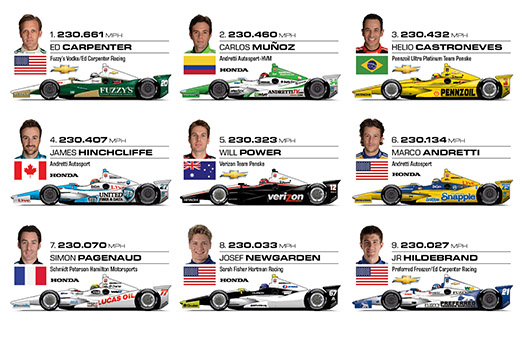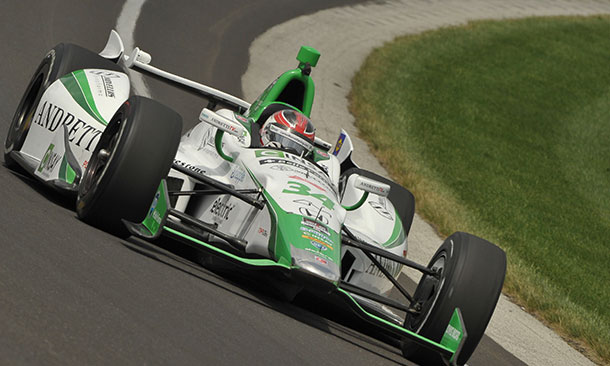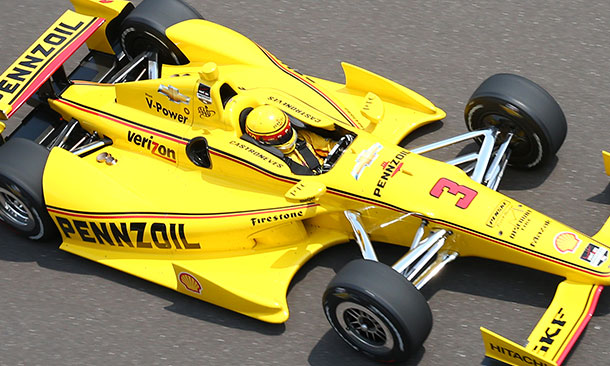This year's qualifications for the 98th running of the Indianapolis 500 (next Sunday) were totally different than the 115 year-old Speedway has ever seen before...
...whereas always before the fastest qualifier today - Pole Day - won pole position, thus starting the 500 on the inside of the first of 33 rows of 3, now the top 9 qualifiers today will again battle it out tomorrow to see who grabs the Pole.
The following 9 drivers each get a 4-lap qualification run tomorrow; whomever is the fastest for those 4 laps wins the Pole. The other 8 drivers' speeds will determine how they fill out positions 2-9 for The Greatest Spectacle in Racing.
1 20 Ed Carpenter 2:36.0735 230.661
2 34 Carlos Munoz 2:36.2090 230.460
3 3 Helio Castroneves 2:36.2286 230.432
4 27 James Hinchcliffe 2:36.2452 230.407
5 12 Will Power 2:36.3022 230.323
6 25 Marco Andretti 2:36.4306 230.134
7 77 Simon Pagenaud 2:36.4741 230.070
8 67 Josef Newgarden 2:36.4993 230.033
9 21 JR Hildebrand 2:36.5032 230.027

These remaining 24 drivers (with their qualifying speeds for today listed) will also requalify tomorrow to determine starting positions 10-33
10 26 Kurt Busch 2:36.5493 229.960
11 28 Ryan Hunter-Reay 2:36.5904 229.899
12 98 Jack Hawksworth 2:36.6471 229.816
13 2 Juan Pablo Montoya 2:36.6681 229.785
14 19 Justin Wilson 2:36.7821 229.618
15 9 Scott Dixon 2:37.0111 229.283
16 7 Mikhail Aleshin 2:37.1426 229.091
17 8 Ryan Briscoe 2:37.3252 228.825
18 14 Takuma Sato 2:37.3522 228.786
19 83 Charlie Kimball 2:37.4043 228.710
20 15 Graham Rahal 2:37.4364 228.664
21 22 Sage Karam 2:37.4460 228.650
22 6 Townsend Bell 2:37.5435 228.508
23 10 Tony Kanaan 2:37.5944 228.435
24 11 Sebastien Bourdais 2:37.6265 228.388
25 63 Pippa Mann 2:37.6474 228.358
26 17 Sebastian Saavedra 2:37.6917 228.294
27 5 Jacques Villeneuve 2:37.7766 228.171
28 33 James Davison 2:37.7912 228.150
29 16 Oriol Servia 2:37.8713 228.034
30 18 Carlos Huertas 2:37.9011 227.991
31 68 Alex Tagliani 2:38.0246 227.813
32 41 Martin Plowman 2:38.5601 227.043
33 91 Buddy Lazier 2:38.9102 226.543
Some badazz automobiles on the track today:

Today's fastest driver and last year's Pole winner, Ed Carpenter of the USA

Columbia's Carlos Munoz cruisin'

Former Dancing with the Stars champ Helio Castroneves tip-toeing down the front stretch
The 10th fastest qualifier today is also trying to become just the 4th driver to ever compete in the Indianapolis 500 and the Coca-Cola 600 on the same day...

Kurt Busch waiting in the box
All photos and info courtesy indycar.com
...whereas always before the fastest qualifier today - Pole Day - won pole position, thus starting the 500 on the inside of the first of 33 rows of 3, now the top 9 qualifiers today will again battle it out tomorrow to see who grabs the Pole.
The following 9 drivers each get a 4-lap qualification run tomorrow; whomever is the fastest for those 4 laps wins the Pole. The other 8 drivers' speeds will determine how they fill out positions 2-9 for The Greatest Spectacle in Racing.
1 20 Ed Carpenter 2:36.0735 230.661
2 34 Carlos Munoz 2:36.2090 230.460
3 3 Helio Castroneves 2:36.2286 230.432
4 27 James Hinchcliffe 2:36.2452 230.407
5 12 Will Power 2:36.3022 230.323
6 25 Marco Andretti 2:36.4306 230.134
7 77 Simon Pagenaud 2:36.4741 230.070
8 67 Josef Newgarden 2:36.4993 230.033
9 21 JR Hildebrand 2:36.5032 230.027

These remaining 24 drivers (with their qualifying speeds for today listed) will also requalify tomorrow to determine starting positions 10-33
10 26 Kurt Busch 2:36.5493 229.960
11 28 Ryan Hunter-Reay 2:36.5904 229.899
12 98 Jack Hawksworth 2:36.6471 229.816
13 2 Juan Pablo Montoya 2:36.6681 229.785
14 19 Justin Wilson 2:36.7821 229.618
15 9 Scott Dixon 2:37.0111 229.283
16 7 Mikhail Aleshin 2:37.1426 229.091
17 8 Ryan Briscoe 2:37.3252 228.825
18 14 Takuma Sato 2:37.3522 228.786
19 83 Charlie Kimball 2:37.4043 228.710
20 15 Graham Rahal 2:37.4364 228.664
21 22 Sage Karam 2:37.4460 228.650
22 6 Townsend Bell 2:37.5435 228.508
23 10 Tony Kanaan 2:37.5944 228.435
24 11 Sebastien Bourdais 2:37.6265 228.388
25 63 Pippa Mann 2:37.6474 228.358
26 17 Sebastian Saavedra 2:37.6917 228.294
27 5 Jacques Villeneuve 2:37.7766 228.171
28 33 James Davison 2:37.7912 228.150
29 16 Oriol Servia 2:37.8713 228.034
30 18 Carlos Huertas 2:37.9011 227.991
31 68 Alex Tagliani 2:38.0246 227.813
32 41 Martin Plowman 2:38.5601 227.043
33 91 Buddy Lazier 2:38.9102 226.543
Some badazz automobiles on the track today:

Today's fastest driver and last year's Pole winner, Ed Carpenter of the USA

Columbia's Carlos Munoz cruisin'

Former Dancing with the Stars champ Helio Castroneves tip-toeing down the front stretch
The 10th fastest qualifier today is also trying to become just the 4th driver to ever compete in the Indianapolis 500 and the Coca-Cola 600 on the same day...

Kurt Busch waiting in the box
All photos and info courtesy indycar.com



